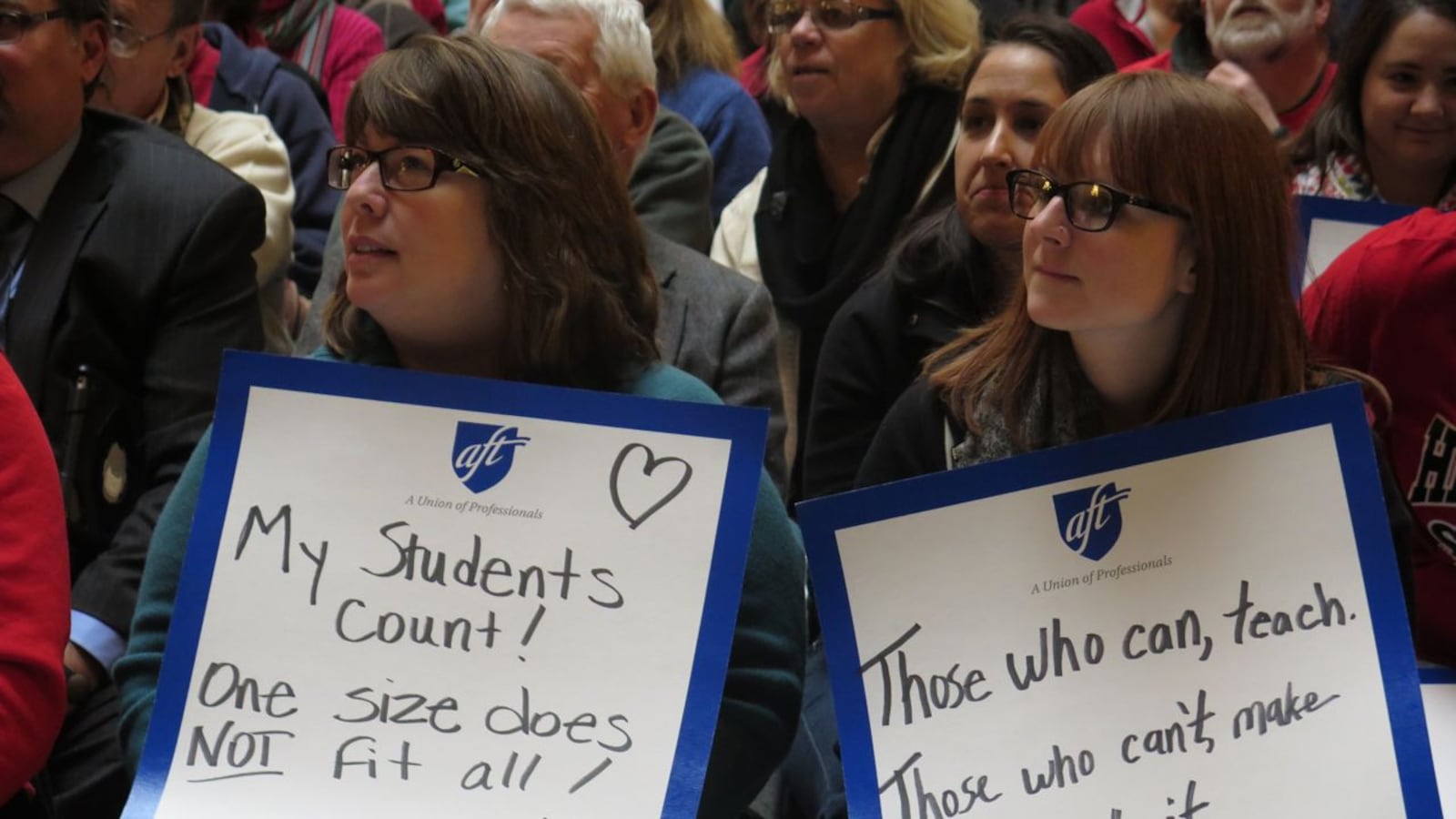(This story is one in a series exploring the basics of key issues in education in Indiana. For a list of the issues and links to the other stories in the series, go here.)
Teachers unions, once a powerful force in Indiana, have struggled in recent years with financial troubles, legal woes and diminished political power.
But with more than 45,000 teacher union members across the state and a former union leader elected as state superintendent of public instruction in 2012, Indiana’s union movement remains influential and is aiming for a revival.
The stakes are high, as strong Republican control of state government has been accompanied by education policies unions view as hostile.
Cuts in state tuition aid to schools during the recession of 2008 and 2009, for example, meant lower raises for teachers in many school districts.
School choice initiatives, including efforts to expand charter schools and private school vouchers, have helped grow enrollment in two sectors of schools that are almost universally non-union.
Some new laws have targeted teacher unions directly, such as when the legislature in 2011 placed strict limits on what issues were subject to negotiations with unions.
Additionally, new state efforts have focused heavily on teachers. A new statewide teacher evaluation system, approved by lawmakers in 2011, makes it easier to fire teachers or block their pay raises.
Countering those efforts has been difficult and, in many cases, unsuccessful. But in other ways, unions have been able to still flex political muscle or otherwise persuade legislators and policy makers to temper their reforms.
Who they represent
Indiana has two statewide teachers unions.
The larger is the Indiana State Teachers Association, which is affiliated with the National Education Association. ISTA has about 40,000 members who belong to 331 local unions. The smaller union is the Indiana Federation of Teachers, affiliated with the American Federation of Teachers. It has about 5,500 members.
Most public school teachers in Indiana are union represented. They pay dues that cover the cost both of service, such as representation in negotiations with their school districts, and for advocacy, such as state and federal lobbying on behalf of teachers’ interests.
In recent years, union membership has been in decline. Partly, this is the result of budget cuts and accompanying job reductions. But also it represents a shift of some jobs to schools where teachers are not union-represented.
Charter schools, for instance, are publicly-funded but privately run. Since their debut in Indiana in 2002, the number of charter schools has now grown to more than 75. Unions have made few efforts to organize teachers at charter schools into unions.
ISTA’s troubles
Since 2009, ISTA has been embroiled in a legal and financial struggle that began with a failed insurance trust.
The fund offered disability insurance to ISTA members and allowed any savings on claims to be invested. When those investments went bad, funds were co-mingled and used to cover shortfalls. But eventually ISTA was left with $57 million in liabilities, a debt which the organization will be paying off for more than a decade.
Indiana ultimately sued ISTA on behalf of local school districts. In December of 2013, ISTA settled with the state, agreeing to pay $14 million without admitting any guilt. It was about half what the state originally sought when it filed the suit. The money was to be split by 26 school districts and could be used in a number of ways, from defraying health care costs to paying for teacher raises.

The liabilities and the suit were not the only consequences for ISTA. The union was sued by its former executive director, who settled for undisclosed terms. It also was taken over by the NEA, which established veto power over its day-to-day decisions and took over ownership of ISTA’s office tower, which stands across from Indiana’s statehouse.
Political problems
ISTA and IFT are strongly allied to the Democratic Party in Indiana. As Democrats have lost power, the teachers unions have seen a corresponding reversal of fortunate on the political front.
In 2010, the Democrats lost their majority in the Indiana House, giving Republicans control of the of both houses of the legislature and the governor’s office.
Led by then Gov. Mitch Daniels, Republicans pushed an aggressive program of education changes that unions opposed. Among them was the creation of a new voucher program, allowing low income families to use tax money intended for their childrens’ public school educations to pay private school tuition.
The legislature also expanded charter schools and required tough new annual evaluations for teachers.
But one new law took direct aim at teacher unions. It overhauled the system of bargaining, stripping unions of the power to negotiate most work conditions. Lawmakers complained about union contract rules, such as those that limited class sizes and the number of after school meetings that teachers could be required to attend.
The new law also compressed the window of time for unions to negotiate with school districts to three months between Aug. 1 and Nov. 1.
During the 2011 legislative session, Democrats fought those laws, and other efforts to contain unions, by fleeing the state during the legislative session. For weeks, Democrats huddled in Illinois, demanding Republicans relent on union and education bills. But in the end, they returned and Republicans passed much of what they had hoped for.
A lone victory
Two years later, Republicans won a supermajority in the House, to compliment its supermajority in the Senate. Along with Gov. Mike Pence, a Republican also elected in 2012, the GOP took total control of the state’s political leadership, with one exception.
The lone Democrat to win statewide office was Glenda Ritz, who pulled a shocking upset by defeating state Superintendent of Public Instruction Tony Bennett. Ritz, a teacher and media specialist in Washington Township, had been the president of her local teachers union. Bennett was a close ally of Daniels, and the face of Republican-led efforts to increase school accountability and promote school choice.
Ritz was strongly supported by teachers unions, and based her campaign mostly on a word-of-mouth approach led in many cases by teachers who disliked Bennett and his policies.

Since taking office, Ritz has waged a public battle for control of education policymaking with Pence and the Republican-appointed Indiana State Board of Education.
A new leader
For the entire Bennett era, ISTA was led by Nate Schnellenberger, a former science teacher who rose to become union president. Schnellenberger had many public battles and debates with Bennett and Daniels over policy and politics.
But in 2013, Schnellenberger retired and ISTA Vice President Teresa Meredith was elected to replace him. Meredith was a Shelbyville kindergarten teacher who began her career as a teacher in a high poverty Indianapolis Catholic school.
Meredith has signaled strong support for Ritz and opposition to efforts by Pence and Republicans that Ritz said aimed to limit her power.
But Meredith has also been supportive of tougher teacher evaluation, saying she would like to see the 2011 law work effectively to improve teacher quality.
In 2015, teachers unions renewed efforts to combat bills aimed at expanding school choice programs, charging Pence and Republicans want to privatize more schools and education services. They also strongly backed Ritz in her battle with Pence and Republican appointees on the state board.
-Updated December 2015

